Chicken Tamales
Green Chicken Tamales are among the most beloved varieties in Mexico. These little bundles of joy are filled with tender, flavorful chicken drenched in a tangy salsa verde. As if that weren’t enough, they are infused with the aromatic spices that are the heart of Mexican cuisine.

The Story Behind These Chicken Tamales
As a type 1 diabetic, I’m always finding ways to tweak my favorite classic recipes, adding a nourishing element without compromising on the ingredients I love. These Green Chicken Tamales have quickly become a favorite!
My focus was on reducing the masa by creating a thinner layer, so I adjusted the masa to a looser consistency. This change made it easy to achieve that lighter, yet flavorful tamal. This allowed us to pack them with protein, all drenched in a traditional salsa verde with the added goodness of spinach.
The inspiration for adding spinach comes from the classic Mexican Mole Verde and Green Pozole, which gets its vibrant green color from leafy greens and veggies. By incorporating these tweaks and carefully carb-counting, the Power-Packed Green Chicken Tamales were born!
After countless recipe tests (and plenty of tamales to go around), Nelson took some to work, I shared them with neighbors, and the reviews were glowing! When I revealed the hidden nutritional boost—the addition of spinach—everyone was amazed. What a clever way to sneak in some nutritious greens without anyone noticing!

Ingredients
- Chicken thighs are naturally juicy and packed with flavor. Their higher fat content helps retain moisture, making them the perfect choice for tamales.
- White onion offers a gentle sweetness, while garlic contributes a sharp, distinct flavor. When cooked together, they create a rich and flavorful base.
- Bay leaves provide earthy tones, while Mexican oregano adds a floral, earthy richness. Cumin seeds introduce warm, nutty, and smoky notes, balanced by a hint of heat from black pepper. Combined with allspice and cloves, these aromatics elevate and deepen the dish’s flavor profile.
- Cilantro’s bright, citrusy notes, combined with epazote’s unique earthy richness, create a perfectly balanced, herbaceous flavor profile.
- Peppers, tomatillos, and spinach contribute a vibrant green color and bold flavor, while the spinach adds an extra boost of fiber.
- Tomato paste, rich in natural umami, intensifies the dish’s depth and flavor.
- Corn masa harina is a finely ground flour made from dried corn kernels that have undergone nixtamalization, a process that softens the kernels and enhances their flavor. Though sometimes referred to as corn flour, it is distinctly different from cornmeal.
- Baking powder softens the masa, giving it a lighter texture and a slight rise, which results in a tender, less dense dough.
- Pork lard infuses a rich, traditional flavor, while avocado oil provides a neutral balance. Together, they ensure tamales are moist, tender, and full of authentic taste.
- Corn husks are essential for tamales, providing structure to shape the masa and filling while locking in moisture. They also lend a subtle, earthy flavor to the dish.

How to Make Green Chicken Tamales
Cook the Chicken
Trim any excess skin from the chicken thighs, then generously season both sides with salt and ground pepper.
Heat 2 tablespoons of avocado oil in a large pot over medium-high heat. Place the chicken thighs skin-side down and brown both sides. Work in batches if needed to avoid overcrowding.


Pour in the water and add the browned chicken back into the pot. Then, add the onion, garlic, allspice, bay leaves, and cilantro. Bring to a boil, reduce the heat to medium-low, cover, and gently simmer for 20-25 minutes, or until the chicken is fully cooked.
Once the chicken is cooked, turn off the heat and remove the chicken from the broth. Let it cool slightly, then carefully strain the broth and set it aside.
Chicken Filling
Preheat the oven to high broil.
Arrange the tomatillos, peppers, chile, onion, and garlic in a single layer on a parchment-lined sheet pan. Drizzle with oil and broil for 10-15 minutes, or until the surface is blistered and blackened.

Once the roasted ingredients are done, remove them from the oven and let them cool. When the chicken is cool enough to handle, shred it, discarding the bones and skin.
Transfer the roasted ingredients to a blender, peeling the garlic cloves and removing the skin from the poblano peppers and stems from the chiles de árbol. Add the cloves, cumin, oregano, spinach, cilantro, and 2 cups of chicken broth. Blend until smooth.

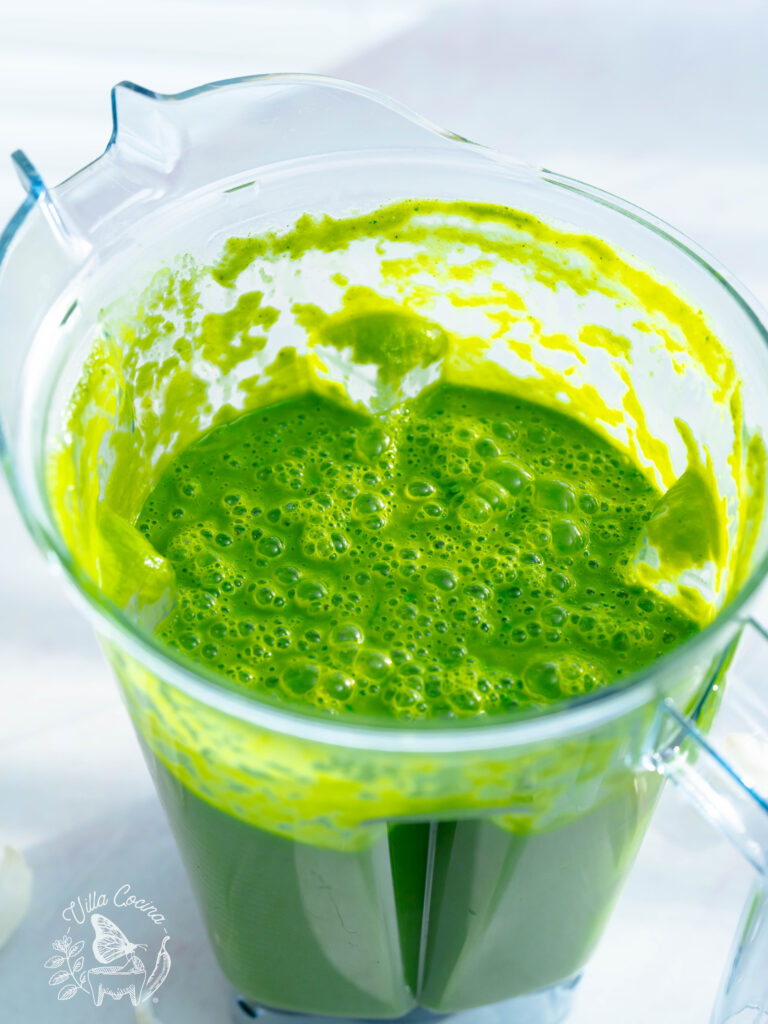
Reserve 2 cups of the green sauce for the masa and set aside, using the remainder for the next step.
In a large pan, heat 2 tablespoons of oil over medium-low heat. Cook the tomato paste for 1 minute, then carefully pour in the green sauce. Add the remaining 1 cup of broth to the blender to capture any leftover sauce, swirl, and stir into the pot. Bring to a gentle simmer. Add the epazote and gently simmer for 5 minutes.
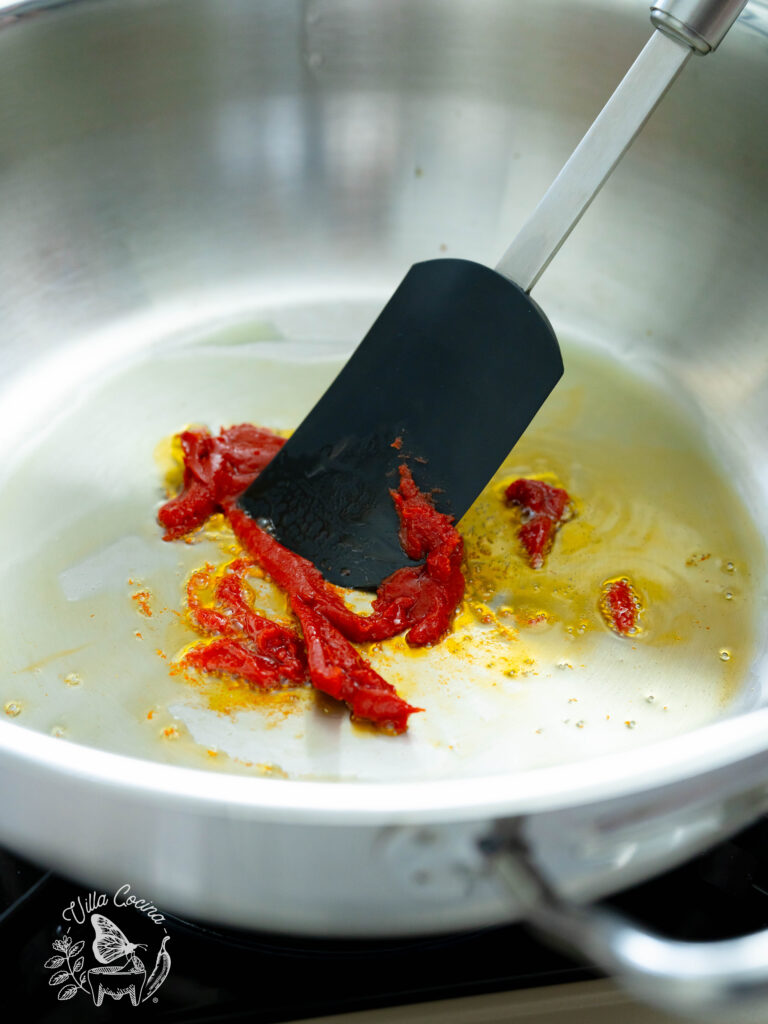

Remove the epazote sprig, then stir in the shredded chicken and cook for an additional 5 minutes. Finally, season with salt, turn off the heat, and let the mixture cool completely before assembling the tamales.


Corn Husks
Sort through the husks, selecting medium to large ones without holes or dark spots for wrapping the tamales. Any imperfect ones can be set aside for use during cooking.
Submerge the husks in warm to hot water for 15–30 minutes, or until softened. Rinse them, remove any corn silk, drain, and transfer to a container. Then, dry them completely with a kitchen towel.
Masa – Dough
In a large bowl, whisk the lard until smooth and lump-free. Then, whisk in the avocado oil until fully combined and smooth.


In a separate bowl, mix the corn masa harina, baking powder, and kosher salt until evenly combined.
Add the masa mixture in two parts, kneading between each addition until the lard mixture is fully incorporated and the dough reaches a crumbly consistency.


Knead in the 2 cups of green sauce until fully combined. Gradually add the broth, kneading the dough after each addition. The dough should be moist, spreadable, and loose but not runny. The amount of broth may vary depending on its temperature; I used about 3 cups.
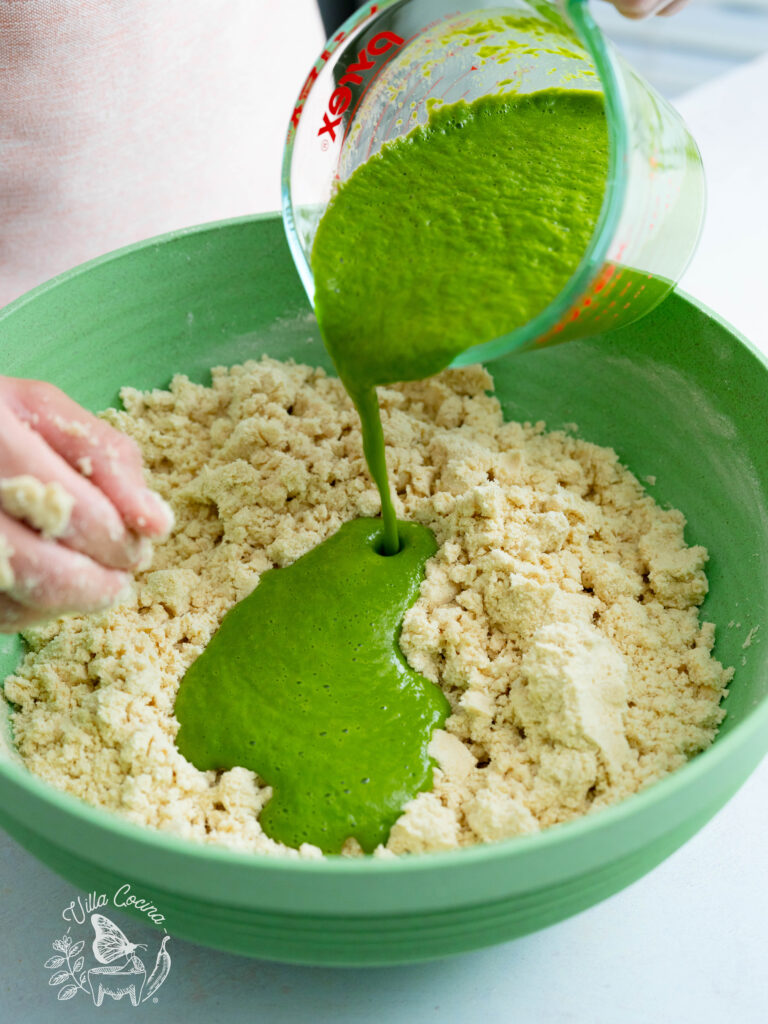

Cover the dough with a damp kitchen towel to prevent it from drying out. If it does, add more broth to adjust the consistency.

Assemble the Tamales
Spread a thin layer of masa over the smooth side of the corn husk using a flexible spatula or bench scraper. Cover about two-thirds of the husk, leaving some space on both sides and the top.
Spoon a generous amount of chicken filling onto the center of the masa, leaving enough space on the sides to close the tamal.

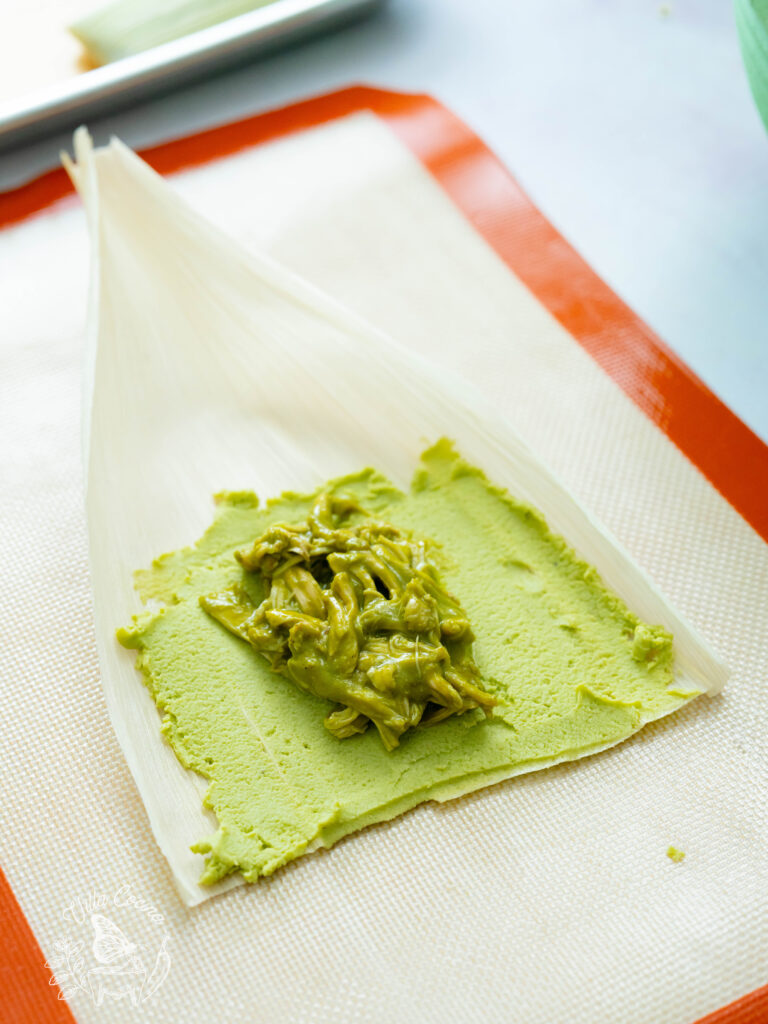
Now, seal the edges of the masa, keeping the husk ends together, fold, and roll.


Feel where the masa ends at the top and fold downward, making sure the flap stays under to keep the tamal closed. Transfer onto a sheet pan and continue making the rest.


Cook the Tamales
Use a large steamer pot and add enough water to reach just below the rack, ensuring it doesn’t touch the tamales while cooking. Line the rack completely with additional corn husks, using the imperfect ones if needed.
Arrange three tamales in a “T” shape, with the open ends facing inward to create a stable base.

Arrange the remaining tamales around the base, with the open ends facing up. Cover with the imperfect husks to prevent water from getting in.


Let the water come to a boil over medium-high heat. Then, cover the pot, lower the heat to medium-low, and simmer gently for 60-90 minutes, or until the dough is fully cooked. Add more water to the bottom of the pot if it’s running low.
Remove a tamal from the pot and let it cool for 5-10 minutes before unwrapping. If it releases easily from the husk, holds its shape, and doesn’t taste like raw masa, it’s ready. Turn off the heat and keep the pot covered if not in use.
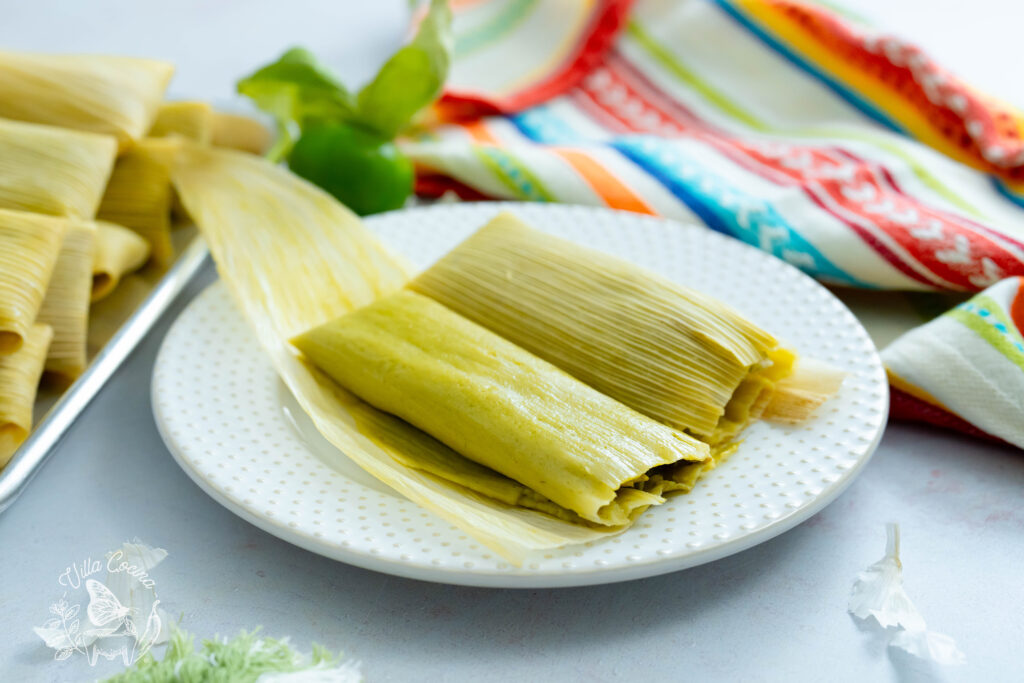
Recipe Video Tutorial
Below is my easy to follow video tutorial on how to make these Chicken Tamales .
Enjoyed the video? Subscribe and tap the bell for updates on new recipes. Thank you for your support!
Masa Consistency
As mentioned, the goal was to create a looser, more spreadable masa—slightly different from the one in my Mexican Red Pork Tamales Recipe. By reducing the amount of carbs, I ended up doubling the yield of tamales, which is a win! Plus, they’re freezer-friendly, making them even more worthwhile to prepare.
Personally, I found that using a flexible kitchen tool made spreading the masa super easy. It might take a little practice, but once you get the hang of it, you’ll be flying through the process! A spatula or bench scraper is my go-to tool for this step.
If you’re finding it difficult to spread the masa, it might need to be looser. Add a bit more broth, a little at a time, until it becomes easy to spread. If the masa becomes too runny, don’t worry—simply mix in a bit more masa harina to bring it back to the right consistency.
Corn Husks
When preparing your husks, select medium to large ones without holes or significant dark spots for wrapping the tamales. Small holes near the top of the husk that don’t interfere with the filling can still work. Imperfect husks can be set aside for lining the pot or covering the tamales during cooking.
If you run out of larger husks, you can overlap two smaller ones and spread the masa—this may take a little extra effort, but it’s doable! A few small dark spots are okay, but avoid using husks with mold or extensive stains.
When assembling, always spread the masa on the smooth side of the husk. To identify it, run your fingers over the surface—the smooth side will feel noticeably different.

Store
- Refrigeration: Leftover tamales can be stored in airtight containers or Ziploc bags in the refrigerator for 3-4 days.
- Freezing: Allow the tamales to cool completely before placing them in freezer-safe bags. Keep the husks on and remove as much air as possible. Label the bags with the name and date to keep track. Tamales can be stored in the freezer for up to 6 months.
- To reheat, thaw the tamales in the refrigerator overnight. Once thawed, steam or microwave them to heat through.
Explore More Tamal Varieties
- Mexican Red Pork Tamales
- Chile Verde Pork Tamales
- Green Chicken Tamales
- Red Chicken Tamales
- Duck Tamales

Tamal Pairings
In my family, tamales were always enjoyed simply, paired with a comforting cup of atole or champurrado—classic sweet Mexican beverages. Growing up in Michoacán, this was the tradition I cherished.
However, Mexican cuisine is wonderfully diverse, and it’s fascinating to think about how tamales are served in other regions or by different families. Some ideas could include:

Chicken Tamales
Ingredients
Cook the Chicken
- 6 lb chicken thighs , (skin on, bone-in)
- 10 cups water
- 1 white onion, halved
- 1 head garlic, slice end off
- 1/2 tsp whole allspice
- 2 bay leaves
- 1/2 bunch cilantro
- Salt and pepper, generously
Chicken Filling
- 1 lb tomatillos
- 4 poblano peppers, halved and seeded
- 2 chiles de árbol, halved and seeded (optional)
- 1/2 white onion, cut into thin wedges
- 6 garlic cloves, unpeeled
- 5 oz spinach leaves
- 4 whole cloves
- 1/2 tsp whole cumin
- 1 tsp dried Mexican oregano
- 1/2 bunch cilantro
- 3 cups chicken broth
- 1 tbsp tomato paste
- 1 sprigs epazote
- Salt to taste (2 tsp kosher salt)
Masa Mix
- 6 cups instant corn masa harina
- 1 tbsp baking powder
- 2 tsp kosher salt, or to taste
- 1/2 cup pork lard
- 1 cup avocado oil
- 2 cups green sauce
- 3-4 cups warm chicken broth
Additional Items
- 45 corn husks, approximately
- Avocado oil, as needed
Instructions
Cook the Chicken
- Trim any excess skin from the chicken thighs, then generously season both sides with salt and ground pepper.
- Heat 2 tablespoons of avocado oil in a large pot over medium-high heat. Place the chicken thighs skin-side down and brown both sides. Work in batches if needed to avoid overcrowding.
- Pour in the water and add the browned chicken back into the pot. Then, add the onion, garlic, allspice, bay leaves, and cilantro. Bring to a boil, reduce the heat to medium-low, cover, and gently simmer for 20-25 minutes, or until the chicken is fully cooked.
- Once the chicken is cooked, turn off the heat and remove the chicken from the broth. Let it cool slightly, then carefully strain the broth and set it aside.
Chicken Filling
- Preheat the oven to high broil.
- Once the roasted ingredients are done, remove them from the oven and let them cool. When the chicken is cool enough to handle, shred it, discarding the bones and skin.
- Transfer the roasted ingredients to a blender, peeling the garlic cloves and removing the skin from the poblano peppers and stems from the chiles de árbol. Add the cloves, cumin, oregano, spinach, cilantro, and 2 cups of chicken broth. Blend until smooth.
- Reserve 2 cups of the green sauce for the masa and set aside, using the remainder for the next step.
- In a large pan, heat 2 tablespoons of oil over medium-low heat. Cook the tomato paste for 1 minute, then carefully pour in the green sauce. Add the remaining 1 cup of broth to the blender to capture any leftover sauce, swirl, and stir into the pot. Bring to a gentle simmer. Add the epazote and gently simmer for 5 minutes.
- Remove the epazote sprig, then stir in the shredded chicken and cook for an additional 5 minutes. Finally, season with salt, turn off the heat, and let the mixture cool completely before assembling the tamales.
Corn Husks
- Sort through the husks, selecting medium to large ones without holes or dark spots for wrapping the tamales. Any imperfect ones can be set aside for use during cooking.
- Submerge the husks in warm to hot water for 15–30 minutes, or until softened. Rinse them, remove any corn silk, drain, and transfer to a container. Then, dry them completely with a kitchen towel.
Masa – Dough
- In a large bowl, whisk the lard until smooth and lump-free. Then, whisk in the avocado oil until fully combined and smooth.
- In a separate bowl, mix the corn masa harina, baking powder, and kosher salt until evenly combined.
- Add the masa mixture in two parts, kneading between each addition until the lard mixture is fully incorporated and the dough reaches a crumbly consistency.
- Knead in the 2 cups of green sauce until fully combined. Gradually add the broth, kneading the dough after each addition. The dough should be moist, spreadable, and loose but not runny. The amount of broth may vary depending on its temperature; I used about 3 cups.
- Cover the dough with a damp kitchen towel to prevent it from drying out. If it does, add more broth to adjust the consistency.
Assemble the Tamales
- Spread a thin layer of masa over the smooth side of the corn husk using a flexible spatula or bench scraper. Cover about two-thirds of the husk, leaving some space on both sides and the top.
- Spoon a generous amount of chicken filling onto the center of the masa, leaving enough space on the sides to close the tamal.
- Now, seal the edges of the masa, keeping the husk ends together, fold, and roll. Feel where the masa ends at the top and fold downward, making sure the flap stays under to keep the tamal closed. Transfer onto a sheet pan and continue making the rest.
Cook the Tamales
- Use a large steamer pot and add enough water to reach just below the rack, ensuring it doesn’t touch the tamales while cooking. Line the rack completely with additional corn husks, using the imperfect ones if needed.
- Arrange three tamales in a ‘T’ shape, with the open ends facing inward to create a stable base.
- Arrange the remaining tamales around the base, with the open ends facing up. Cover with the imperfect husks to prevent water from getting in.
- Let the water come to a boil over medium-high heat. Then, cover the pot, lower the heat to medium-low, and simmer gently for 60-90 minutes, or until the dough is fully cooked. Add more water to the bottom of the pot if it’s running low.
- Remove a tamal from the pot and let it cool for 5-10 minutes before unwrapping. If it releases easily from the husk, holds its shape, and doesn’t taste like raw masa, it’s ready. Turn off the heat and keep the pot covered if not in use.
Nutrition
Did you make this recipe?
Show some love! Tag @villacocinaofficial on Instagram and drop a 5-star review. Your support means everything—thanks!


Reyna
Amazing
Villa Cocina
Glad you loved them!